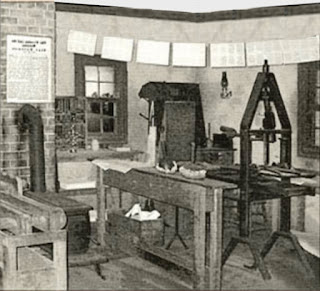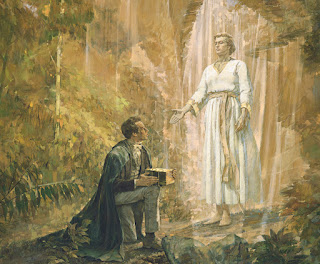We have received the following comments and questions from our readers:
• Comment: The more I have studied the Book of Mormon, particularly about the geography, the more it has become clear that there were some significant clues. Just as obviously, however, these clues can be interpreted many ways—no one’s way is necessarily correct.
Response: There should be no difference of opinion based upon the scriptural record. As an example, when Lehi said to his sons: “And now, my sons, I speak unto you these things for your profit and learning; for there is a God, and he hath created all things, both the heavens and the earth, and all things that in them are, both things to act and things to be acted upon” (2 Nephi 2:14, emphasis added), there are not two ways to interpret this—God created the earth and all things in it.
Helaman teaching the Nephites who had gathered to listen to him
Or when Helaman taught: “And now remember, remember, my brethren, that whosoever perisheth, perisheth unto himself; and whosoever doeth iniquity, doeth it unto himself; for behold, ye are free; ye are permitted to act for yourselves; for behold, God hath given unto you a knowledge and he hath made you free,” there is no different way to interpret that man is free to act for himself—the agency to choose right or wrong on his own.
The same can be said about the geography descriptions as well. After all, north is north and south is south despite John L. Sorenson’s attempt to claim a so-called “Nephite North” or “Mormon North” meaning “east and west,” not “north and south.” Mormon makes it clear with a lengthy description of the layout of the Land of Promise (Alma 22:27-35). Or that Nephi knew cardinal directions: “we traveled for the space of four days, nearly a south-southeast direction, and we did pitch our tents again; and we did call the name of the place Shazer” (1 Nephi 16:13, emphasis added).
Sometimes understanding is aided by a knowledge of Hebrew, and an understanding of ancient Hebrew/Jewish customs. Sometimes it is a knowledge of geologic facts and scientific principles. But in the end, it is not difficult to accurately interpret the meanings of the Book of Mormon geography. The real issue is not to have a predetermined place or location in mind that clouds the true meaning of the writing.
• Comment: To clarify, are you saying that the entire Andes mountain range rose out of the water in only three hours?
Response: The Disciple Nephi, who experienced these events, makes it clear: “When the thunderings, and the lightnings, and the storm, and the tempest, and the quakings of the earth did cease—for behold, they did last for about the space of three hours; and it was said by some that the time was greater; nevertheless, all these great and terrible things were done in about the space of three hours—and then behold, there was darkness upon the face of the land” (3 Nephi 8:19, emphasis added).
• Comment: How is it possible for mountains to become valleys and other valleys to become mountains of great height?”
Tectonic Plate Movement showing subduction of the low density Oceanic Plate beneath the more density South American Plate
Response: It is a matter of tectonic plates moving beneath the oceans and continents, constantly moving into one another, forcing one plate down below another, called subducting—the sliding of one plate beneath another. Typically, an oceanic plate slides under a continental plate because of the difference in density, causing earthquakes at the surface and pushes up the land, forming mountains—causing dramatic changes to the earth’s surface. This is because the lithosphere is pretty thin, even though it contains all of the crust and a thin slice of the upper mantle.
The asthenosphere beneath it, which is much more massive, moves very slowly as it is roiled by the much hotter rock beneath it forming convective currents in the asthenosphere which rise up in some places, moves laterally, and sinks down in other places.
Typically, this is a long-term event and these changes occur slowly, except for an initial earthquake which occurs suddenly at the surface, causing a tsunami, which is the displacement of a large volume of water generally caused by the earthquake. Tsunamis hit suddenly, with little warning, sometimes catastrophically, but always in a few hours or a day or two and its gone and the aftermath forgotten (except for those in the near-destroyed areas); however, when the Lord’s hand is involved (“darkness should cover the face of the whole earth for the space of three days” –Helaman 14:27), then the time frame is very quick by comparison (earth was divided in the days of Peleg) and the events can be quite noticeable (mountains rising from valleys “whose height is great” –Helaman 14:23).
• Comment: “How could an entire continent, or at least the area of Brazil, rise up out of the water as you say?”
Continental Crust or Plate is more dense than the Oceanic Crust or Plate, forcing the Oceanic Plate to subduct beneath the South American Plate
Response: Continental crust is less dense than oceanic crust. Older and colder oceanic crust is denser than younger oceanic crust. It is this difference in density that results in one plate sliding under the other as they are forced together. Subduction can occur between continental and oceanic crustal material, but also between two oceanic crusts of different density based on age. If the crust has the same density, the two plates pile up against one another. The Himalaya are an example of this, but the piling up effect also explains the massive Tibetan Plateau, which overall involves a much larger uplifted area, though not as massively high as the zone of collision at the Himalaya.
This is how Brazil, or more accurately the Amazonian Drainage Basin, which makes up about 35% of the present-day South American continent, rose up out of the water, resulting from this subduction of the Pacific Plate or the Nazca Plate beneath the South American Plate. As for mountains becoming valleys as Samuel the Lamanite prophesized (Helaman 14:23), subduction also involves a second element, which is down welling of the asthenosphere.
Although this is the vast change to the surface, and the raising of the Andes Mountains, such tectonic collision resulting from this collision on the surface, the motion of these two plates is also influenced by the asthenosphere beneath them, which is also in collision. This is where the downward leg of convective motion is taking place, and the earth above tends to flatten in places—such as the Amazonian Draining Basin.
When crust forms at the mid-ocean ridges it is somewhat hotter than the average that would be found on the sea floor. This is because it is thinner and the result is that it is also less dense than the average sea floor.
As the crust moves further from the mid-ocean ridges, it cools and thickens. As a result, the density increases. As it subducts beneath the Continental Plate, it pushes the Continental Plate upward, and in many cases, out of the water to form the land, as it did in both the Tibetan Plateau and South America.
(See the next post, “Questions About the Geography of the Book of Mormon – Part II,” for more questions about the geography and how certain areas were formed that cause a lot of difficulty for people to grasp or accept and reject South America as the location of Lehi’s landing in his Land of Promise)

























